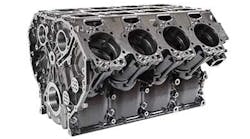Carbide cutters tame titanium machining
The prolific use of complex, monolithic titanium components in aircraft has led to increasingly higher demand for better titanium machining capabilities.
Improving cutting tool performance has become a priority, given the usual slow machining cycle times on large prismatic parts that are cut on big gantry machining centers.
Many of these parts are designed with deep pockets and thin walls to meet weight-saving design objectives. In many aircraft/aerospace
programs, cost reduction becomes a focus for attention only after the program is well underway, and after the initial priorities of component quality and weight reduction are met.
However, if all three priorities – component quality, light weight and reduced costs –can be addressed simultaneously in the early stages, costs can be minimized from the start.
This was the approach taken by MAG Maintenance Technologies (www.maint-tech.com) and MAG Cincinnati (www.mag-ias.com) when they partnered with a major U.S.-based commercial aircraft manufacturer to develop equipment, cutting tools, and processes that would significantly reduce the cost per piece of machining titanium.
The challenges
Dramatic improvements in the speed of material removal and increasing the number of cuts between tool regrinds were the objectives, particularly for rough-out and finish operations on 8-in. deep pockets in titanium parts.
Previously, the norm was 4-in. inch pockets because deeper cuts were not practical. Another mandate was to machine part walls thinner than 0.060 in.
The benchmark for cubic-inch-perminute titanium removal rates was 3 cu-in./min for roughing operations, and the best performance that had been achieved to date on the new prevalent Ti-5553 alloy was 1.5 cu-in./ min. with a tool life of one hour. That was not nearly good enough.
Process efficiency goals also called for the elimination of hand polishing components.
After several years of intensive development, these goals were met and, in some cases, greatly exceeded.
Productivity has been improved four times the level of what was experienced previously.
MAG Cincinnati and MAG Maintenance Technologies are the exclusive suppliers of Technicut tooling, and the Maintenance Technologies’ Productivity Solutions group worked with UK-based Technicut Ltd., a brazed-carbide and solid carbide tooling application expert, to develop the applications.
Tooling developments
The MAG companies and Technicut developed several carbide cutting tools with dramatic results in cutting titanium.
Michael Judge, the director of productivity solutions at MAG Maintenance Technologies, said, “Brazed carbide, and the evolutionary development of cutting geometries and approach techniques, are the key factors that have allowed us to cut 6-in., 7-in., and 8-in. pockets without slowing down the cutting rate to a crawl.”
“We have evolved a series of products, putting our knowledge from previous experience to work to apply the tools, figuring out how to get the very best from these tools for the specific machining tasks, “Paul Graham, director of Technicut Ltd., said.
A brazed-carbide plunger roughing tool was engineered to deliver a unique combination of high wear resistance at the cutting edges and body toughness to absorb the high levels of vibration associated with titanium cutting.
A 2-in. O.D. cutter with an 8-in. projection and a step-over of only 0.5 in., now is removing titanium at a rate of over 5 cu-in./min. This is quadruple the normal capabilities of HSS.
For example, in a previous aerospace application, a HSS cutter with the same dimensions removed 1 cu-in./min., with 30 minutes of tool life between regrinds.
The MAG brazed-carbide tool, which also had an 8-in. projection, hogged off 4.5 cu-in./min. with triple the tool life – 90 minutes.
Based on the shop’s hourly rate, and the cost of the tool and regrinds, the total “removal” cost for titanium with the MAG tool was $1.30/cu. in.,compared with $5.84/cu.in.
The initial higher cost of the tool was far exceeded by the fact that it could be reground 10 times – with grinding required on the end teeth only – coupled with the extended time between regrinds and the huge gain in removal rate productivity.
Another MAG tool, the Raptor mill, achieved a titanium removal rate of 9 cu-in./min, finishing the part in a single operation.
The semifinish operations have been eliminated, producing a part that, in the words of one process engineer, goes from “forging to flight” in record time. In other aerospace applications, the brazed-carbide Raptor provided a 30-times increase in productivity, with tool life doubled.
MAG Maintenance Technologies also formulated a multi-flute brazed carbide finisher, dubbed the “Dreamcutter,” that has proven to be successful on finish cuts on thin wall applications of 8-in. deep with weight-saving wall thicknesses of 0.060-in. thick.
The Dreamcutter carves 8-in. pockets with no visible steps over its entire length, and with maximum thickness variance of 0.005 in.
The company said its aerospace application studies have shown that the cost per cubic-inch-removed with its tool plunged to as little as 1/50th of the cost of using HSS.
A fourth MAG cutting tool product, the Mega-Flute, has been used in finishing operations on many aircraft programs using titanium and high tensile alloys, and has achieved significant cycle-time productivity gains through the ability to feed at over 100 in./min, sustain a material removal rate of 3 cu-in./min while comfortably achieving over one hour of continuous cutting.






